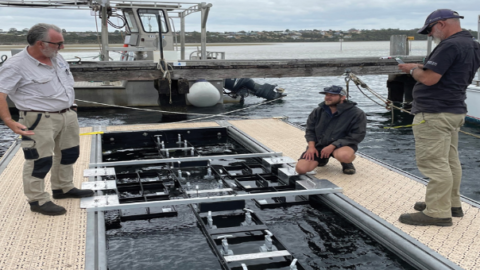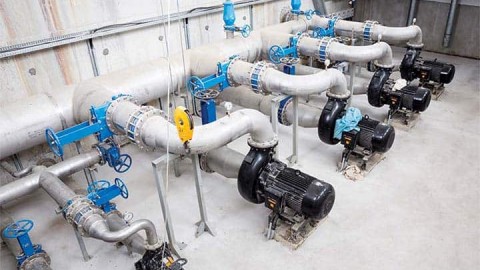The PIA’s Australian Pump Technical Handbook is a cornerstone text for the Australian pump industry and, in our opinion, a must have for anyone who deals with pumps on a regular basis. In this ongoing series, we feature abridged chapters from the classic book to showcase the various areas covered and to reacquaint readers with the technical aspects of pumps. In this issue, we go into detail regarding selecting and applying different types of positive displacement pumps.

While economic considerations often mean that centrifugal pumps are used for applications handling low viscosity, clean fluids or very high flow rates, there are many applications where the specific requirements of the fluid or process make positive displacement pumps the first choice.
Circumstances where positive displacement pumps are often used include:
- Low flow, medium to high head applications – in such applications positive displacement pumps can be substantially more efficient than centrifugal pumps
- Medium to very high viscosity fluids
- Low flow slurries (soft or hard solids, abrasive or non-abrasive depending on the type of positive displacement pump)
- Where near constant flow rate is required regardless of pressure conditions, without the need for complex flow control systems
- Where a moderate to high efficiency needs to be maintained over a wide range of flows and/or pressures
- Where self-priming is an advantage – most positive displacement pumps have a much better priming capability than self- priming centrifugal pumps
- Where liquids contain entrained gases
- Where shear-sensitive liquids must be pumped with minimal damage
- Where flow direction needs to be reversed for process or flushing reasons
- Where large soft solids need to be pumped with minimal damage
- Where solids content is very high and liquid content is low
Reciprocating piston and plunger pumps
A reciprocating positive displacement pump is one in which a plunger or piston displaces a given volume of fluid with each stroke.
The plunger or piston is contained in a liquid cylinder and to pump the liquid, the plunger or piston must be moved. When the plunger or piston is moved out of the cylinder the pressure is reduced, allowing fluid to flow into the cylinder through the suction valves.
Then the plunger or piston moves back into the cylinder and the fluid is pressurised and exits via the discharge valves. This part of a reciprocating pump is called the “fluid end”.
At what is known as the “drive end”, reciprocating piston and plunger pumps usually use crankshafts, connecting rods, and crossheads to provide reciprocating motion to either single or double-acting pistons or single-acting plungers.
Pistons are equipped with sliding seals to limit pumped liquid slip past the piston, and both types of pump are fitted with stationary seals to stop leakage into the reciprocating mechanism. Inlet and outlet valves control fluid flow into and out of the cylinder.
Single cylinder pumps are used rarely, due to high discharge pulsations. Triplex, quintuplex, septuplex (three, five and seven cylinders) are much more common because they provide much lower pulsations.
Standard seal and valve construction is generally limited to relatively clean fluids, but the pumps can usually be provided with abrasion-resistant seals, valves, liners or plungers to reduce wear in applications containing abrasive solids. Some designs are also engineered to minimise downtime when replacing worn components.
Piston pumps are usually limited to discharge pressures of around 100bar, while plunger pumps are commonly suitable for 700bar but are also readily available for ultra high pressures to 2,750bar.
Within the pressure range where both piston and plunger pumps are available, piston pumps are usually easier and less costly to maintain. Capacities range up to 100L/sec for piston pumps and 315L/sec for plunger pumps.
Many of the lower-cost general-purpose designs are made for stock in standard cost-effective materials for general clean non-corrosive liquid applications. Engineered designs are available in a wide range of materials to cover a wide range of corrosive and abrasive liquids.
Selection of reciprocating piston and plunger pumps
The selection process for a piston or plunger pump is usually relatively simple.
For clean, low viscosity fluids all that is required is that:
- The pump manufacturer’s maximum fluid end pressure is not exceeded
- The pump manufacturer’s maximum speed is not exceeded
- The duty suction conditions are within the selected pump’s NPSHR needs
- The fluid end materials are compatible with the fluid pumped
- The size of the pump is usually selected from a table showing the maximum speed, flow and pressure for each size/model. Once the size/model is selected, the pump speed for a specific capacity is usually calculated.
For applications where the pumped fluid is viscous and/or has entrained solids, additional considerations must be taken into account. These include the type of inlet and outlet valves that are most suitable, and that the power rating of the pump’s drive end is not exceeded. For these duties it is recommended that the end user work in close cooperation with their pump supplier.
Characteristics of reciprocating piston and plunger pumps
Like most positive displacement pumps, piston and plunger pumps are basically constant volume machines where flow rates are independent of pressure. Flow control is usually obtained by varying the pump operating speed.
Drive end assemblies are designed for a maximum power rating and can be fitted with a range of fluid ends to provide low flow, high pressure or high flow, low pressure.
Advantages:
- Deliver fluid at high pressure (i.e. high discharge head)
- Self-priming (however, this can be strictly limited due to the configuration of the suction valves, and in many cases a high acceleration head, so that to prevent cavitation a booster pump is required on the pump suction)
- High efficiency
Disadvantages:
- Give a pulsing flow
- Close fitting moving parts cause maintenance problems
- Viscous liquids can cause suction problems
- Expensive outside mass-produced low power pumps
Common applications for reciprocating piston and plunger pumps
Common applications for standard designs include:
- General pressure wash
- High-pressure cleaning
- Heavy vehicle washing
- Sewer jetting
- Misting for temperature or humidity control
- Dust suppression
Common applications for engineered designs:
- Drilling mud
- Reverse osmosis
- De-scaling
- Water jet cutting
- Chemical injection
- Crude oil transfer
- Mine dewatering
- Ore pipeline transport (slurry version)
Air-operated diaphragm pumps
Air-operated diaphragm pumps are made by many manufacturers with a range of standard materials, diaphragm, and valve types that allow a wide range of applications.
Air-operated diaphragm pumps usually have two diaphragm pumping chambers with diaphragms connected by a push rod and actuated by compressed air. Each chamber has inlet and outlet check valves which are usually ball or flap type, and connected by inlet and outlet manifolds.
Actuation of the diaphragms is controlled by an air distribution valve. Some types of air valves require oil-lubricated compressed air but others are made to be operated by non-lubricated air.
When the left diaphragm is pressurised outward, the connecting rod pulls the right diaphragm inward on a suction stroke, which fills the left chamber with fluid. Liquid enters the pump at the suction manifold, moves through an open suction check valve and fills the chamber.
As the air distribution valve directs pressurised air to the left of the diaphragm, the diaphragm is pushed outward forcing liquid from the left outer chamber. Discharged liquid moves from the chamber, through an open discharge check valve, and exits the pump at the discharge manifold. The position of the discharge port can be at the top, the bottom or the side.
At the end of the cycle, the air distribution valve automatically shifts the air pressure to the opposite diaphragm, initiating another cycle.
Selection of air-operated diaphragm pumps
The selection of air-operated diaphragm pumps is usually determined by the fluid capacity and pressure required by the application, and from a performance curve, the air pressure needed to meet these conditions.
Air-operated diaphragm pumps range up to 100mm discharge size with capacities to 100m3/h and heads up to around 9bar.
Characteristics of air-operated diaphragm pumps
Due to their sealless construction and the many different materials from which diaphragms, valves or the pump body can be made, air-operated diaphragm pumps can be used in a wide range of applications, including those where leakage can be hazardous, or where the fluid is corrosive or contains moderate amounts of abrasive or sensitive solids.
Self-priming and dry-running capabilities, in addition to ease of capacity control are also important in many applications. Pressure relief valves are not necessary since the maximum discharge pressure is limited by the pressure of the compressed air supply.
Air-operated diaphragm pumps are also portable and easy to set up.
However, air-operated diaphragm pumps may be unsuitable for applications where overall energy consumption is an important factor, as the air compression and expansion cycle in inherently inefficient.
Common applications for air-operated diaphragm pumps
Common applications for air-operated diaphragm pumps include:
- Chemical transfer – acids, solvents, resins, latex
- Food transfer – ice cream, sauces
- Tanker and drum unloading
- Contaminated bilge and pump pumping
- Clay slurries
- Polymer
Further information and detailed diagrams, equations and schematics can be found in the Australian Pump Technical Handbook, available from the PIA website. In the next edition of Pump Industry, we continue our explorations into the selection and application of different types of positive displacement pump.

















